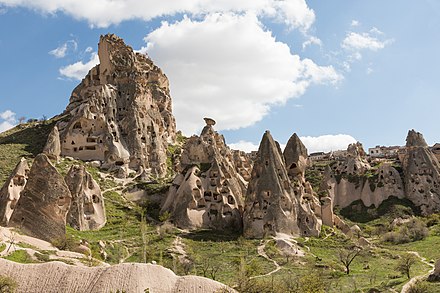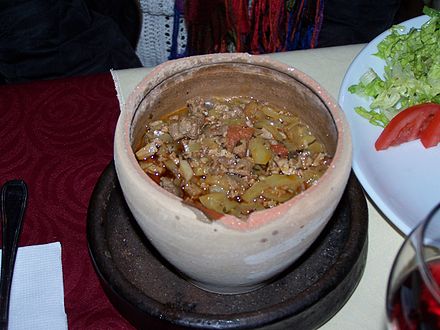 Cappadocia (Turkish: Kapadokya) is an area in Central Anatolia in Turkey best known for its unique moon-like landscape, underground cities, cave churches and houses carved in the rocks.
Cappadocia (Turkish: Kapadokya) is an area in Central Anatolia in Turkey best known for its unique moon-like landscape, underground cities, cave churches and houses carved in the rocks.
Cities

- Avanos – pottery town located on the banks of the longest river in Turkey - Kizilirmak river
- Cavusin
- Göreme – fairy chimneys in the rock city. The main tourist spot in Cappadocia.
- Güzelyurt – historic town close to Ihlara Valley
- Nevsehir – capital of the region
- Ortahisar – features rock castle
- Uçhisar – superb views of the Cappadocia valley that can be seen from its rock castle
- Ürgüp – cave dwellings, as well as the rock cones in and around this city

Other destinations
- Ihlara Valley (Ihlara Vadisi) – lots of churches carved into rocks, and a beautiful canyon. You are urged to walk along the valley and explore the churches and its numerous frescoes. This valley is about an hour west of the core of Cappadocia, i.e. Ürgüp/Göreme area.
Understand
The ancient region of Cappadocia is located in central Anatolia between the cities of Nevsehir, Nigde and Kayseri. Millions of years ago violent eruptions of the volcanoes Mount Erciyes and Mount Hasan covered the surrounding plateau with tuff. Wind and weather have eroded the soft volcanic rock into hundreds of strangely shaped pillars, cones and "fairy chimneys", in colours ranging from pink to green and yellow. Since antiquity, people have hollowed out these soft rocks, and they have made countless cave churches, chapels and monasteries.
The churches are from the early years of Christianity. The art style of the churches can be classified into two categories: the 8th and 9th century are the iconoclastic years, the 10th to the 13th centuries whose decorations represent the lives of Christ and various saints. The architecture of the churches is uncomplicated.
History
The prehistoric settlements of the area are Koskhoyuk (Kosk Mound) in Nigde, Aksaray Asikli Mound, Nevsehir Civelek cave and, in the southeast, Kultepe, Kanis and Alisar in the environs of Kayseri. This area with unusual topographic characteristics was regarded as sacred and called, in the Scythian/Khatti language, as Khepatukha, meaning "the country of the people of the chief god Hepat", although there are more poetic claims on the origin of the region's name, such as the Old Persian Katpatuka, which is said to mean "the land of beautiful horses". The tablets called Cappadocian Tablets and the Hittite works of art in Alisar are of the important remains dating from the 2000s BC. After the 1200s BC, the Tabal principality, of the Khatti Branches of Scythians, became strong and founded the Kingdom of Tabal. Following the Late Hittite and Persian aras, the Cappadocian Kingdom was established in 332 BC. During the Roman era the area served as a shelter for the early escaping Christians. There are also several underground cities used by early Christians as hideouts in Cappadocia.
When the Turks started to arrive in the region after immigrating from their homeland in Central Asia around the 11th century, they found the area largely uninhabited. Seeing the strange, upheld rock formations drilled inside out as they were, they concluded that these should have been the chimneys of the homes of the otherkin, thus providing the popular name for the "fairy chimneys" (a direct translation of Turkish peri bacası).
Climate
Capadocia has a semi-arid, continental climate; very warm, dry summer days with chilly nights and cold, snowy winters. Spring features the (in)famous storm season of inland Anatolia, called Kırkikindi, bringing heavy showers and thunderstorms. Fall is mild and dry, making it the best time to visit, especially in September.
The biggest city in the region, Nevsehir, has detailed information of the region's climate on its page.
Get in
Due to its location, roundtrip bus travel to Cappadocia can be tiring, and air travel expensive. If you book your ticket in time, flights tickets can be as cheap as a bus ticket. Many people visit as part of a larger circular tour of Western Turkey, usually utilizing the well-developed intercity bus system and/or one-way flights.
By bus
Most of the bus companies have bus services to Nevsehir and Göreme.
Getting from Kayseri to Cappadocia (Göreme and Nevsehir) is easy and takes less than an hour.
By plane
-
Nevşehir Kapadokya Airport (IATA: NAV) is located in Gülşehir town of Nevşehir Province. Turkish Airlines operates direct flights from Istanbul to Nevsehir Kapadokya throughout the day.
-
Kayseri Erkilet Airport (IATA: ASR) in Kayseri is an hour's drive to the center of Cappadocia. Turkish Airlines operates several direct flights from Istanbul (IATA: IST). There are also daily flights from Izmir via Istanbul with Turkish Airlines and direct flights of Antalya or Izmir are available on proper days of the week. It's easy to arrange a transfer or shuttle bus from Kayseri Airport to Cappadocia.
By train
Kayseri is on a busy railway route. It is possible to find suitable trains to Kayseri from almost all the train stations of Turkey.
Get around
Major tourist spots are well connected by Dolmus.
You may want to consider either renting a car or buying a tour package. However, you will come across exorbitantly priced car rentals, as much as 190 TL per day. Bargaining is needed in such instances.
See
- Göreme, its surroundings, and the nearby underground cities are why many people visit this region.
- Old Greek houses in Sinasos

- Mustafapaşa and İbrahimpaşa towns
- Zelve Open Air Museum – a ghost town with lots of caves. It's about 10 km from Goreme or 5 km from Avanos. Zelve is also one the most impressing valleys in the region offering a more disorganised and rough hike.
- Gümüşler Monastery. Spectacular monastery carved in rock, hidden from the outside world. Dated at 10-11th century and only recovered in the 1960s. The ticket seller speaks some English and can give you a tour. The monastery has some well preserved frescoes, including the only smiling (Mona Lisa-style) Madonna in the world. 3 TL
Do
- Hiking – Following the paths along the valleys of Cappadocia is an amazing (and free) option. Check with your hotel owner or the tourist office for a map of the area with suggested walks and trails. There are several nice loops on packed dirt, sand and rock, that maintain a constant elevation and pass through the scenic valleys.
- Pretty much all of the most common tourist activities are available in Göreme, including balloon trips at sunrise on the bucket list of many travellers to Cappadocia.
Buy
Cappadocia is an important area for shopping, with wonderful carpets and kilims, hand made local pottery by artisans and very local wines.
Eat and drink
- Dry apricots and grapes
- Mantı (kind of ravioli with minced meat served with yoghurt and garlic sauce)

- Testi Kebap (jug kebap) – Meat and vegetables cooked in a clay pot (or jug) sealed with bread dough. The pot is broken when serving.
- Pastirmali kuru fasulye – white beans with spiced meat
- Local wines – Cappadocia is one of the biggest wine-producing regions in Turkey, and many wineries throughout the region's towns offer winetasting options.
Sleep
Visitors are recommended to stay in one of the cave hotels which are the speciality of the region, but even a simple hostel will offer this opportunity. Most options and budgets are available in Göreme. There are also many accommodation options in Urgup, Uchisar, Ortahisar and Avanos.
You can find also bewitching historical Greek mansions and cave hotels in Güzelyurt.
The towns of Ibrahim Pasa (Babayan) and Ayvalı are probably the most authentic ones. The restored Greek houses offer cave and arched rooms offer pleasant accommodation, at a price.
Go next
- Aksaray – A laid-back city and great hub for the surrounding attractions near Güzelyurt, or like Tuz Gölü ("Salt Lake"), the second largest lake in Turkey is becoming a popular day trip from the Cappadocian towns, to wade across it shallow waters and to take a few pictures of its vivid, dreamlike views.
- Konya – The home of Sufi poet and thinker Rumi and of an outstanding Seljuk architecture is a sensible next destination, if you have not already arrived from that direction.